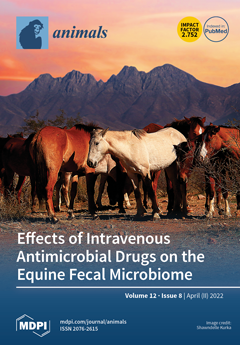Twenty-four healthy castrated male Holstein growing cattle, with similar body weight (301 ± 11.5 kg), were enrolled in this study and randomly allocated into two groups (12/pen). Holstein growing cattle in the LPT (low NFC/NDF pelleted TMR) group were fed basal pelleted TMR with a low NFC/NDF ratio (NFC/NDF = 1.07), while the HPT (high NFC/NDF pelleted TMR) group were fed with a high NFC/NDF ratio diet (NFC/NDF = 1.71). The results showed that: (1) Body measurements were found to be increased for the LPT group (
p < 0.05); compared with the HPT group, feed intake to gain ratio and feed cost in the LPT group were decreased by 12.24% and 15.35%, respectively (
p < 0.01). Compared with the HPT group, the LPT group tended to increase chest girth. (2) Digestibility of DM and NDF in the LPT group was higher (
p < 0.05) than in the HPT group, being increased by 3.41% and 4.26%, respectively, and increased digestibility of ADF in the LPT group was significant (
p < 0.01). (3) The daily feed consumption of NDF in the LPT group was higher than that in the HPT group and the daily rumination time and chewing time in the LPT group were longer than that in the HPT group (
p < 0.05). (4) Compared with the LPT group, the parameter of pH, microbial protein and acetate: propionate (
p < 0.05) in the HPT group were decreased by 8.57%, 12.46% and 23.71%, respectively. In contrast, the concentration of total volatile fatty acids, acetate and propionate were higher (
p < 0.05) in the HPT group, and increased by 13.49%, 19.59% and 52.70%, respectively. (5) Compared with the LPT group, rumen fluid in the HPT group diet up-regulated the mRNA expression levels of BRECs pro-inflammatory factor IL-1β and TNF-α (
p < 0.05), and meanwhile, up-regulated the mRNA expression levels of BRECs pro-inflammatory factor IL-6 (
p < 0.01); compared with the LPT group, rumen fluid in the HPT group diet up-regulated the mRNA expression levels of CCL28 and CCL20 (
p < 0.05) chemokines in CCL types of BRECs; in addition, compared with the LPT group, rumen fluid in the HPT group up-regulated the mRNA expression levels of CXCL2, CXCL3, CXCL9 and CXCL14 chemokines in CXCL types of BRECs (
p < 0.01), and the mRNA expression levels of the CXCL5 chemokine tended to be increased (
p = 0.06).
Full article






